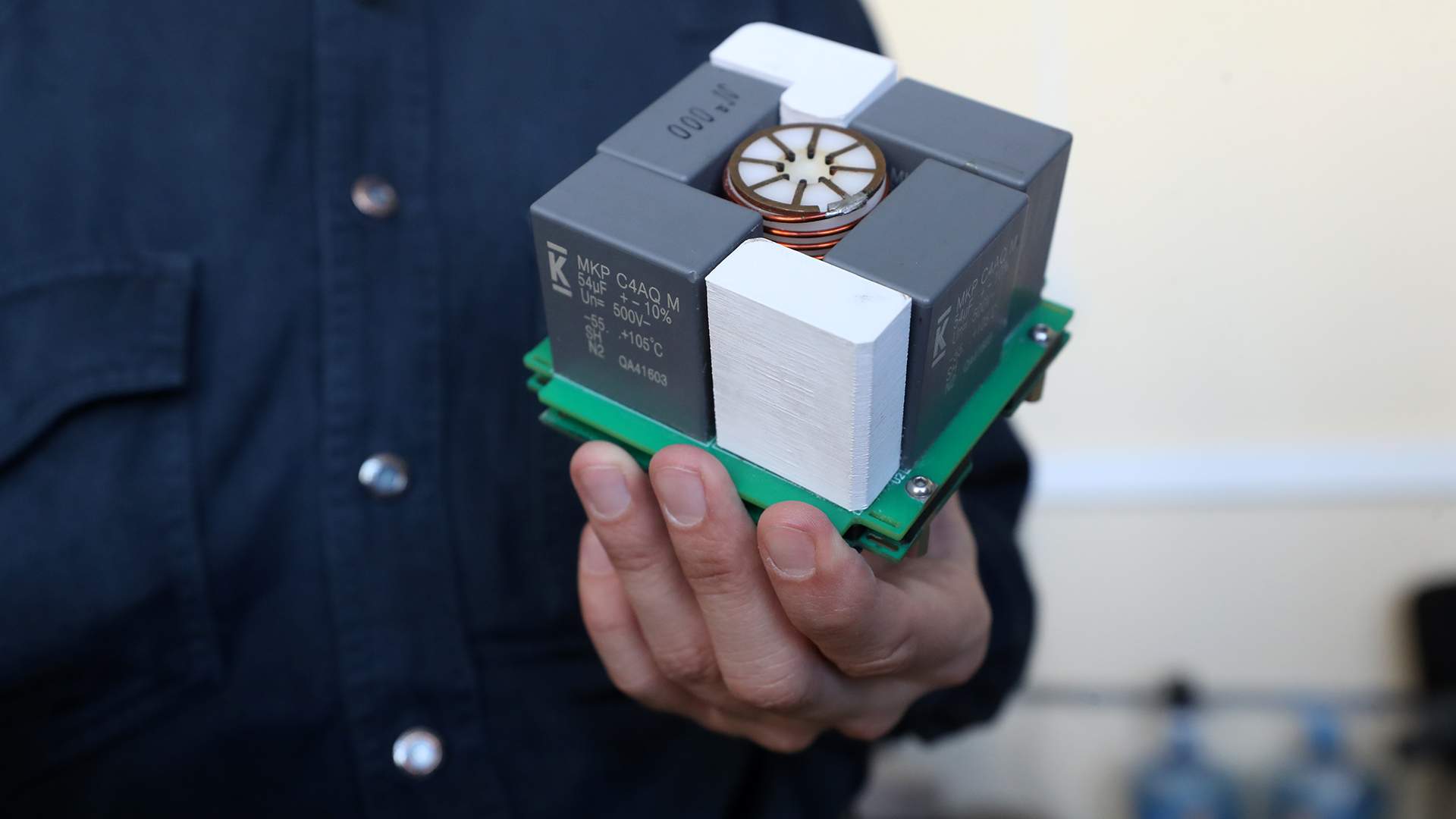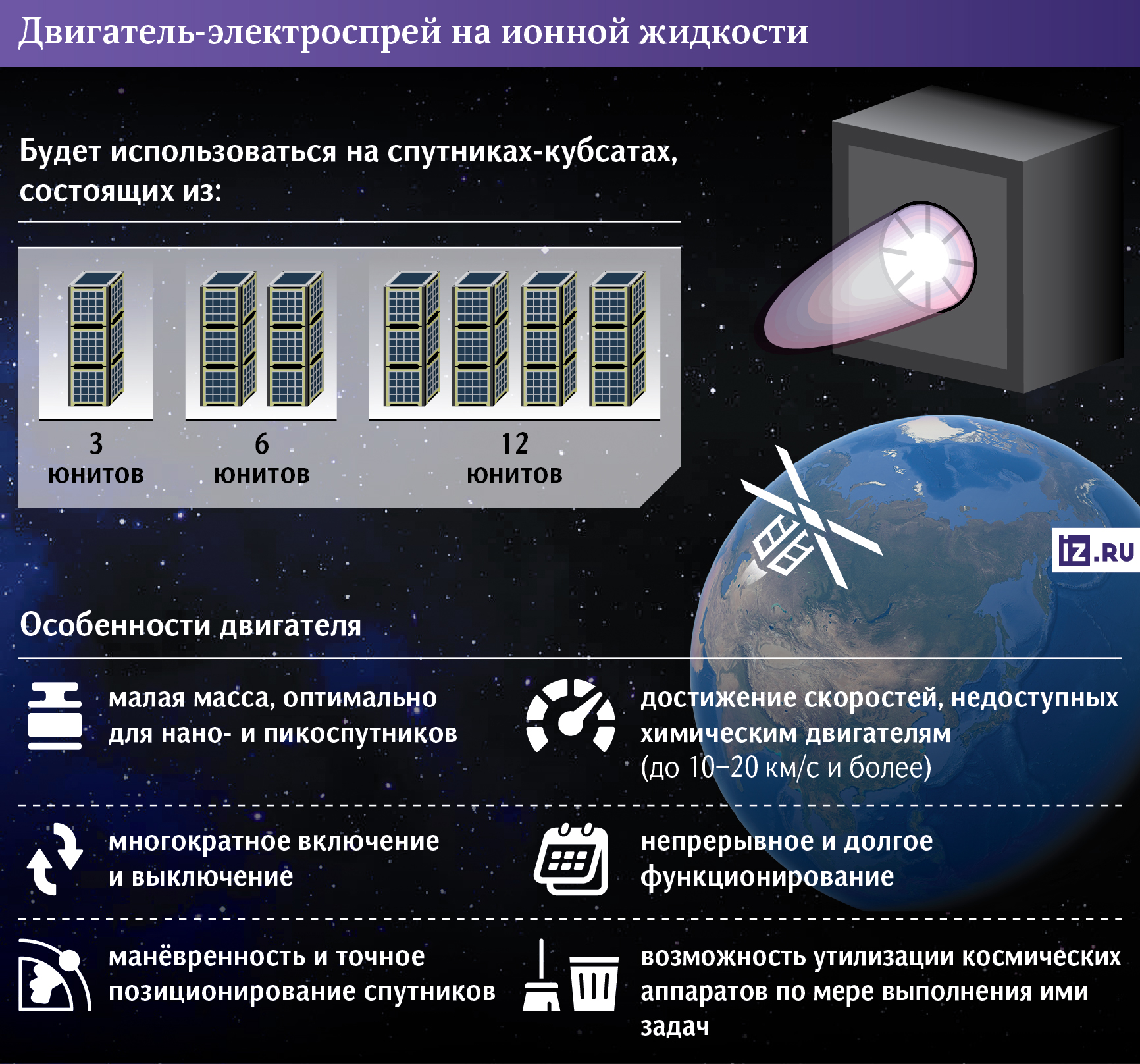- Статьи
- Science and technology
- Spray for business: new Russian engines will deliver nanosatellites to the Moon
Spray for business: new Russian engines will deliver nanosatellites to the Moon

Scientists have developed a preliminary design for an innovative electrospray rocket engine powered by an ionic liquid. It is designed for small spacecraft of the "nanosatellites" class. The project is based on a number of ideas that will make it possible to make a more efficient engine than its global counterparts. In particular, such power plants will help ensure the accurate positioning of spacecraft in swarms, as well as solve the problem of space debris and deliver nanosatellites from high near-Earth to lunar orbit.
How plasma will help achieve high speeds
Scientists and engineers from the National Research Nuclear University MEPhI and the innovative enterprise Satellite Technologies and Astrodevelopment (STAR) have prepared a preliminary design for electric colloidal rocket engines of the electrospray type. They are designed for small nanosatellite-class spacecraft, including the Cubesat format. This is a platform based on a typical cubic module with 10-centimeter faces.
As the researchers explained, the development is a power plant in which ionic liquids are used as a working fluid. These are salt melts consisting of a mixture of positive and negative ions. They are attracted to each other by electrostatic forces, but they do not combine into a closed molecule. At the same time, under the influence of a strong electric field, the ions gain acceleration, break out and form a jet stream.
— Plasma acceleration by electricity is the most effective way to accelerate the working fluid to high speeds. Unlike traditional engines, where the flow rate of a jet stream is limited by the energy of a chemical reaction, there is no such ceiling for a plasma stream. As a result, the power plants are capable of accelerating vehicles to 10-20 km/s or more. Such speeds open up new horizons for space research," Igor Egorov, chief designer of the project, senior lecturer at the Department of Plasma Physics at the Institute of Laser and Plasma Technologies at the National Research Nuclear University MEPhI, told Izvestia.
According to him, the development is based on ideas that, once implemented, will make it possible to obtain an engine more efficient than its global counterparts. In particular, one of the tasks is to choose the right liquid.
For example, table salt (sodium chloride), when heated to a melting point (about 800 ° C), also turns into an ionic liquid. It consists of charged particles of sodium and chlorine. And it can be used as a working fluid for rocket engines, but you will have to spend a lot of energy heating the substance. Therefore, in practice, more complex compounds are used, which in space conditions will already be in a liquid state. One of the objectives of the project is to identify such compounds and choose the optimal one, the scientist explained. In particular, the working fluid must evenly consume positive and negative ions.
— With the development of new technologies, space becomes accessible not only to large government agencies, but also to the private sector, universities and scientific institutes. On their part, there is an interest in small satellites and their engines. The demand of the Russian market is about 70 such devices per year," said Evgeny Stepin, project manager, Director of the Center for Space Research and Technology at the National Research Nuclear University MEPhI, CEO of STAR.
He added that private investments have been attracted to carry out research and development work on the project. At the first stage, the scientists intend to confirm the parameters inherent in the design of the electrospray engine and create a laboratory sample of the installation. These works will be completed in 2025, and in the following years the team expects to enter mass production of products.
— Electric motors powered by ionic liquid can significantly increase the discharge rate of the working fluid. This significantly increases their capabilities. In particular, calculations show that a cubesat of 12 units with a colloidal engine can fly from a geostationary near-Earth orbit (at an altitude of 36,000 km) to a lunar orbit. Now rockets are launched to the geostationary regularly. If we simultaneously deliver a small spacecraft there, which will get to the vicinity of the Moon by itself, this will significantly reduce the cost of such missions," Igor Egorov noted.
In his opinion, the cost of such flights will tend to zero. Meanwhile, nanosatellites can help in the preparation of large spacecraft expeditions to the moon. In particular, using cubesats, specialists can study the terrain where the lunar module is expected to land.
As for Mars, the scientist added, nanosatellites will not reach there on their own. However, if they are somehow delivered to the Red Planet, they will be able to slow down using ion liquid engines and maneuver in Martian orbits, performing various missions.
Where colloidal engines are used
— Colloidal engines can have good parameters in terms of the specific thrust pulse (500-1500 s) and the thrust value itself (up to 200 microns/W). They also use available materials as a working hoist. Due to the design features, the units can be manufactured using 3D printing," Alexander Senkevich, General Director of the Zvezda Research and Production Enterprise, commented on the development.
Their main field of application is nano- and picoscale satellites. At the same time, the new engines will help solve the problem of space debris, allowing vehicles to be brought from orbit into the atmosphere as their service life expires, he added.
— Power plants of this type are capable of delivering small but precise thrust pulses with high efficiency. This allows, for example, to adjust the satellite's orbit and smooth out small disturbances caused by solar pressure or residual atmosphere. This is important for long-term missions that require a stable and predictable orbit. For example, when studying gravitational waves or when working as part of a group while pointing at the same area in deep space," explained Viktor Bulybenko, CEO of RST Space, developer of small satellites and ultralight launch vehicles.

In his opinion, the main difficulty that the designers need to overcome is to ensure stable and reliable operation of these small engines, since it is required to precisely shape the particle jet, avoiding, for example, the formation of their large accumulations on the emitters (emitters).
In addition, such power plants contain high voltage sources, as well as a number of other important elements that must withstand operation for hundreds and thousands of hours in space conditions. At the same time, the expert noted, since electrospray engines are supposed to use both positive and negative ions, a special ionic liquid is needed that works approximately equally in different polarities. Plus, reliable electronics are needed to switch polarities.
Переведено сервисом «Яндекс Переводчик»






